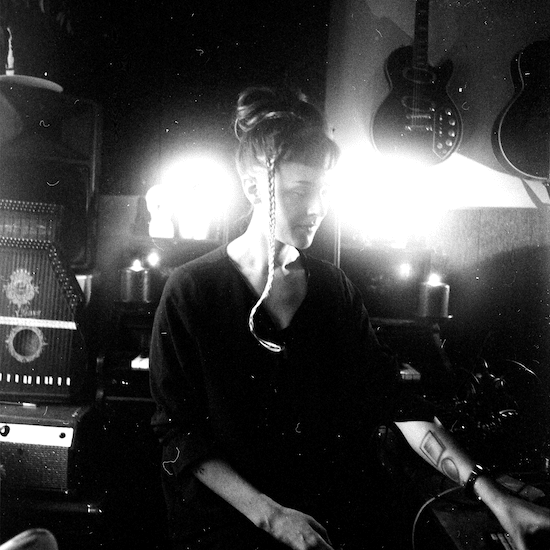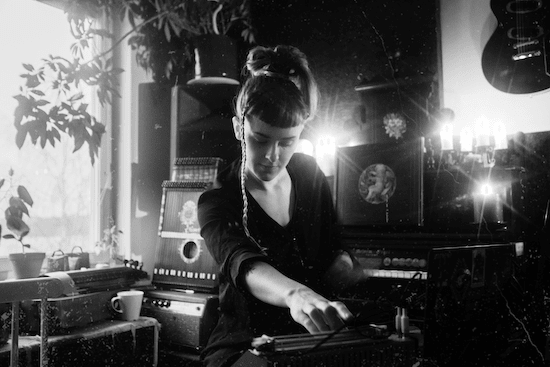Maria W. Horn portraits by Arvida Byström
This year’s ‘offline’ Rewire Festival is held 10, 11, 12 & 18 September in the Hague
Maria W Horn’s Dies Irae is about a reckoning, one dragged from its medieval origins into the present day climate catastrophe. Premiered in Stockholm last summer and soon to be performed at Rewire festival, it contains an arrangement for voice, electronics and tuned glass, for the Latin poem of the same name, which describes the last judgement. In translation it speaks of "a day of wrath" in which "all creation is awaking/to its Judge an answer making". It was partly written while on residence in a mining district in Sweden in 2018, at a time when fires were ravaging nearby forests, and was finished during the pandemic.
"These periods affected the theme, they were a way to channel a lot of my angst about the future, and about the environmental crisis," she says. "It has a lot to do with this constant cognitive dissonance of living in the wealthy western part of the world, where – especially in Sweden – the common view is that we can continue living in eternal economic growth, and just invest ourselves out of this environmental crisis, and never have to sacrifice a single comfort. In contrast to this, the Dies Irae theme is so appealing, because it’s a requiem, so it gives us space where we are allowed to mourn the world."
Horn is a Swedish composer and musician living in Stockholm but originally from the north of the country. Her work is engaged with drone, the dynamics of sonic extremes and their effect on a listener, and with the spaces in which we encounter music. Her music deals in hulking leaden textures alongside sombre harmonies and glacial melodies. It is often gothic in its subject matter – dealing with heavily researched projects on memory and archives, such as the church’s complicity in witch burnings in her album Kontrapoetik, and the memories held in the walls at a prison for her light and sound installation Vita Duvans Lament.
Elsewhere she has homed in on abstractions concerning the structures of light and sound, or constructed formal compositional strategies and processes, such as on Epistasis, which explores a gradual increase in tempo and density and is inspired by the harmonic structure of doom and black metal. In installations she has become interested in light, voltage, feedback, such as on Alternating Currents, a choreographed concert around a frequency-controlled Tesla Coil developed in collaboration with Stina Nyberg, or Interlocked Cycles, which maps coloured light and sound.
Horn grew up Härnösand in the North of Sweden. She played bass in punk bands as a teenager, but aged 16 signed up for an evening class in electroacoustic music composition at a local education centre. Lessons were in a basement studio that was equipped with a computer running Pro Tools, a tape recorder and a small recording room with one microphone, some sound effects CDs, and a big cardboard box filled with broken glass. "My first task was to make a sound collage using these tools" she says. "Being a militant vegan at the time I made a collage illustrating a pig’s last journey to the slaughterhouse, ending with a distorted feedback-loop of screaming pig sounds that I found on one of those CDs."
The basement course was formative, opening up a new world of sonic possibilities as to what it meant to be a musician. After high school she moved to Stockholm to study electroacoustic music, where she became interested in harmony, timbre and music that evolved slowly. She says this interest started around 20 years ago when she was fresh to the city, at a surround-sound space with a speaker dome called Audiorama. "One of my friends at the university showed a drone piece – it was the first time I ever encountered long form music that was minimalist in that sense. It had such a huge impact on me, I remember all the stages I was travelling through… My first reaction was almost anger, because nothing was happening, then after that, I completely lost myself in the music. Afterwards I couldn’t understand what I had experienced, I was like, ‘Is this allowed?! Is music allowed to be like this?’"
Following this revelation, she began composing towards the drone, and towards music that transformed mental states or altered our perceptions of time. She says she feels an inheritor to a strong Swedish drone lineage that runs back to the 1960s and includes microtonal composer and mathematician CC Hennix and Folk Rabe (whose What?? is a lesser known but crucial entry in this canon). To perform this often durational music, Horn and others founded Sthlms Drone Society, a group of composers collaborating to present slowly evolving, textural music, where they would set up immersive multichannel sound environments and stage events that were sometimes up to 12 hours long.
Collectives are core to the social and community side of Horn’s music – she is deeply invested in and engaged with the importance of community in music making, and as such runs the label XKatedral with Kali Malone, which began as a DIY venture to gather music made locally in Sweden that was not making it out further afield. They made photocopied artwork and organised concerts at Stockholm’s experimental music venue Fylkingen. (Friends Sara Fors, Mats Erlandsson, Theodor Kentros and Daniel M Karlsson now also help run the label). Horn also collaborates regularly with Mats Erlandsson, with whom she’s currently working on a commission with at the GRM in Paris, and regularly works with choirs and other musicians to realise her pieces. She says being part of a collective has been essential to how her music has developed, and calls it a "DIT-approach" – do-it-together. "[It] implies a local perspective, to work together with the resources available in the specific situation," she says.
She released her first EPs in 2016. Magenta dealt in caustic rhythms and leaden pulses, and Diverted Units contained serrated and fractious digital noise. 2017’s Excitation – Frustration – Excitation documented a process-based compositional strategy with Mika Vainio-like industrial weight. Her debut album, Kontrapoetik was released in 2018, and was, as she described it a "counter-exorcism" for her relationship to the area she grew up, Ångermanland in the North of Sweden. For it, she dug in on the area’s connection to the worker’s movement in the 1930s and witch trials in the 17th Century. One outcome of her research was the formation of a satanic feminist sect that conducted counter-readings of the Christian genesis narratives. It was not best received back home. "As the cover for the album I used a picture of a local church where many women accused of witchcraft were sentenced to death," she explains. "Drawing these parallels in public received some negative attention by various people in the area, and my mother wrote me a long email worrying about what people in that parish would think if they found out about my project, how I would never be able to get a job in the region again."

Horn says she has an ambivalent relationship to Christianity, rooted in an early experience of her family being stigmatised in their local community, and being thrown out of bible study class and accused of being a satanist for taking a critical approach to the text and listening to heavy metal. "The priest called home to let them know that I was a satanist," she says. "This sense of rejection and feeling of not belonging within the religion and moral belief system that I grew up with made these Christian motifs and spaces even more charged with emotion and ambivalence."
Horn’s primary compositional tool is SuperCollider, but she also uses algorithmic processes. She says the former gave her an understanding of how to control timbres, tunings and textures in her music, but that with the latter, she began to focus more on "the inherent spectral properties of sounds", developing a less linear concept of musical time. "One of the advantages of electronic music production is the ability to work directly with the sounding material, meaning that the pendulum movement between listening and composing can continue in an intuitive cycle," she explains. "Listening is the main tool with which I shape my musical material."
Horn is as much an installation artist as a musician, and the research she undertook for Kontrapoetik led to other archival projects, such as Vita Duvens Lament, a light and sound installation which ran from November 2020 until February 2021 at the Vita Duvan prison in Luleå in the far north of Sweden, the only Swedish prison designed as a panopticon. She read prisoner biographies and interrogation records from the prison, including testimonies where prisoners detailed their poor nutrition, the thin air, and the sensory deprivation they were subjected to when placed in solitary confinement for extended periods.
The installation included recorded voices singing a vocal cycle she composed, but also reciting parts of the prison interrogation records and repetitive word games some prisoners developed to stop themselves from going insane while isolated, with speakers placed in individual cells and lights representing diurnal rhythms. She worked on the installation in winter, meaning it was dark even during the daytime. "In this context of constantly hearing the voices of the installation, the room and its history affected me almost too vividly," she says. "I started hearing things that I wasn’t sure belonged to the installation or not – at some points I thought I was definitely going insane myself."
She says this intensified her impression that places (and people) are never neutral. A place "always carries with it an imprint of its history" she says. "Once you start scratching the surface, history brings forth dimensions that have political, social and personal dimensions".
Just before the pandemic, Horn worked on a collaboration with a childhood friend and folk musician Sara Parkman, with whom she used to play in a folk-rock band as a teenager. They made music for a dance performance rooted in mourning practices, and as part of the research for the project met Pirkko Fihlman, a singer of Finnish lament. "She introduced us to the technique that included writing our personal laments that we were to sing in front of the other people in the group," Horn explains. "The vulnerability and intimacy of the situation was overwhelming, and soon we were all crying together. It made me realise how rare those moments are when we are exposed to other people’s grief and when we let people partake in our personal sorrows. It was beautiful to experience this as a collective ritual practice… it was both strange and helpful to move through the initial pandemic period after having so recently worked with the themes of grief and death."
Horn describes music-making as a transformative experience that she needs, and describes it like growing a garden, where there’s multiple things to take care of at once, in various stages of bloom and decay. "It requires imagination and direction of will," she says. "Presenting my music becomes an extension of this process, a quest to create transformative experiences for others. I think it all boils down to a belief in the mind’s inherent capacity for change, and its ability to imagine new worlds."


